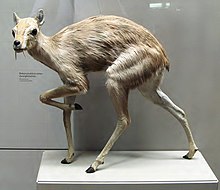Musk deer: Difference between revisions
m →Evolution: copyedit |
|||
| Line 39: | Line 39: | ||
==Evolution== |
==Evolution== |
||
[[Image:Zwerghirsch-Micromeryx-Rekonstruktion.jpg|thumb|left|Reconstruction of the extinct genus ''[[Micromeryx]]'']] |
[[Image:Zwerghirsch-Micromeryx-Rekonstruktion.jpg|thumb|left|Reconstruction of the extinct genus ''[[Micromeryx]]'']] |
||
Musk deer may be a surviving representative of the [[Palaeomerycidae]], a family of ruminants that is probably ancestral to [[deer]]. They first appeared in the early Oligocene epoch and disappeared in the Pliocene. Most species lacked antlers, though some were found in later species. The musk deer are however still placed in a separate family. |
Musk deer may be a surviving representative of the [[Palaeomerycidae]], a family of ruminants that is probably ancestral to [[deer]]. They first appeared in the early Oligocene epoch and disappeared in the Pliocene. Most species lacked antlers, though some were found in later species. The musk deer are however still placed in a separate family.gghhffrtyt6yyt6y767y |
||
==References== |
==References== |
||
Revision as of 23:08, 19 January 2010
| Musk deer Temporal range:
| |
|---|---|

| |
| Moschus moschiferus | |
| Scientific classification | |
| Kingdom: | |
| Phylum: | |
| Class: | |
| Order: | |
| Suborder: | |
| Infraorder: | |
| Family: | Moschidae (Gray, 1821)
|
| Genus: | Moschus (Linnaeus, 1758)
|
| Species | |
| |
Musk deer are artiodactyls of the genus Moschus, the only genus of family Moschidae. They are more primitive than the cervids, or true deer, in not having antlers or facial glands, in having only a single pair of teats, and in possessing a gall bladder, a caudal gland, a pair of tusk-like teeth and—of particular economic importance to humans—a musk gland. Moschids live mainly in forested and alpine scrub habitats in the mountains of southern Asia notably Himalayas.
Characteristics
Musk deer resemble small deer with a stocky build, and hind legs longer than their front legs. They are approximately 80-100 cm in length, 50-70 cm tall at the shoulder, and weigh between 7 and 17 kg. The feet of musk deer are adapted for climbing in rough terrain. Like the Chinese Water Deer, a cervid, they have no antlers, but the males do have enlarged upper canines, forming sabre-like tusks. The dental formula is similar to that of true deer:0.1.3.33.1.3.3
The musk gland is found only in adult males. It lies in a sac located between the genitals and the umbilicus, and its secretions are most likely used to attract mates.
Musk deer are herbivores, living in hilly, forested environments, generally far from human habitation. Like true deer, they eat mainly leaves, flowers, and grasses, with some mosses and lichens. They are solitary animals, and maintain well-defined territories, which they scent mark with their caudal glands. Musk deer are generally shy, and either nocturnal, or crepuscular.
Males leave their territories during the rutting season, and compete for mates, using their tusks as weapons. Female musk deer give birth to a single fawn after about 150-180 days. The newborn young are very small, and essentially motionless for the first month of their life, a feature that helps them remain hidden from predators.[1]
Evolution

Musk deer may be a surviving representative of the Palaeomerycidae, a family of ruminants that is probably ancestral to deer. They first appeared in the early Oligocene epoch and disappeared in the Pliocene. Most species lacked antlers, though some were found in later species. The musk deer are however still placed in a separate family.gghhffrtyt6yyt6y767y
References
- ^ Frädrich, Hans (1984). Macdonald, D. (ed.). The Encyclopedia of Mammals. New York: Facts on File. pp. 518–519. ISBN 0-87196-871-1.
External links
- Guha S, Goyal SP, Kashyap VK. (2007). Molecular phylogeny of musk deer(KASTURI MIRG): A genomic view with mitochondrial 16S rRNA and cytochrome b gene.Mol Phylogenet Evol. 2007 Mar;42(3):585-97.PMID: 17158073. [1]
- Hassanin A, Douzery EJ.(2003. Molecular and morphological phylogenies of ruminantia and the alternative position of the moschidae. Syst Biol. 2003 Apr;52(2):206-28. PMID: 12746147. [2]
